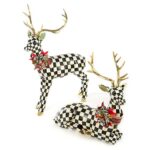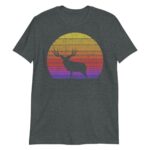Embark on a culinary journey as we delve into the enigmatic world of brisket of a deer, a delicacy steeped in tradition and brimming with unique flavors. From its anatomical origins to its culinary versatility, prepare to be captivated by the allure of this wild delicacy.
Nestled beneath the ribcage, the brisket of a deer is a substantial cut of meat characterized by its rich marbling and distinct gamey flavor. Its versatility extends from hearty stews and braises to succulent roasts and tantalizing smoked preparations.
Terminology and Definitions

In the context of deer anatomy, the brisket refers to a specific region of the animal’s chest.
The brisket is located on the ventral side of the deer, between the forelegs. It is a large, flat muscle that covers the lower part of the chest cavity. The brisket is typically rectangular in shape and can vary in size depending on the age and species of the deer.
Types of Brisket Cuts
The brisket can be divided into several different cuts, each with its own unique culinary applications:
- Flat Cut:This cut is taken from the top of the brisket and is known for its leaner meat and rich flavor. It is often used for slow-cooking methods, such as braising or smoking.
- Point Cut:This cut is taken from the bottom of the brisket and contains more fat and connective tissue. It is typically used for making ground venison or for slow-cooking methods that allow the fat to render out.
- Whole Brisket:This cut includes both the flat and point cuts and is ideal for large gatherings or special occasions. It can be cooked whole using various methods, such as smoking, roasting, or braising.
Nutritional Value and Composition
Deer brisket is a highly nutritious cut of meat, offering a rich source of protein, vitamins, and minerals. Its nutritional profile is comparable to other cuts of venison and even some types of red meat.
Protein Content
Deer brisket is an excellent source of protein, containing approximately 25 grams per 100-gram serving. This protein is high-quality and easily digestible, making it a valuable addition to a healthy diet.
Fat Content
Deer brisket is relatively low in fat, with only about 5 grams per 100-gram serving. Most of this fat is monounsaturated and polyunsaturated, which are considered “good” fats that can help lower cholesterol levels and reduce the risk of heart disease.
The brisket of a deer is a tough cut of meat, but it can be cooked to perfection with the right ingredients. One of the best ways to cook brisket is to slow-cook it with buccees deer corn . The corn adds a subtle sweetness to the meat, and the slow-cooking process helps to break down the tough fibers, resulting in a tender and flavorful dish.
Vitamin Content, Brisket of a deer
Deer brisket is a good source of several vitamins, including:
- Vitamin B12: Essential for red blood cell formation and nervous system function.
- Vitamin B6: Involved in protein metabolism and immune function.
- Niacin: Important for energy production and skin health.
- Riboflavin: Contributes to energy production and vision.
Health Benefits
Consuming deer brisket can offer several potential health benefits, including:
- Muscle growth and repair:The high protein content of deer brisket supports muscle growth and repair, making it a valuable food for athletes and individuals recovering from injuries.
- Reduced risk of heart disease:The low fat content and presence of “good” fats in deer brisket can help lower cholesterol levels and reduce the risk of heart disease.
- Improved cognitive function:The vitamin B12 content in deer brisket is essential for brain health and cognitive function.
Cooking Methods and Techniques: Brisket Of A Deer
Deer brisket is a versatile cut of meat that can be cooked using various methods to achieve optimal tenderness and flavor. Each cooking technique offers unique advantages and disadvantages, catering to different preferences and desired outcomes. Understanding these methods will empower you to create mouthwatering brisket dishes that will impress your taste buds.
Grilling
Grilling is a popular method for cooking deer brisket, imparting a smoky and charred flavor to the meat. By placing the brisket directly over a heat source, such as charcoal or gas, you can create a delicious crust while keeping the interior juicy and tender.
However, grilling requires careful monitoring to prevent burning and ensure even cooking.
Roasting
Roasting involves cooking the brisket in an oven, allowing for even heat distribution and a more controlled cooking process. This method is ideal for larger briskets and results in a tender and flavorful meat. However, roasting can take a longer time compared to other cooking methods.
Smoking
Smoking is a low and slow cooking technique that infuses the brisket with a distinctive smoky flavor. By exposing the meat to smoke for an extended period, you can achieve a tender and juicy brisket with a rich and complex taste.
However, smoking requires specialized equipment and can be time-consuming.
Braising
Braising is a combination of searing and slow cooking in a liquid, typically broth or wine. This method allows the brisket to become incredibly tender and flavorful as the collagen breaks down during the cooking process. Braising is ideal for tougher cuts of meat and results in a fall-off-the-bone texture.
Tips for Optimal Tenderness and Flavor
-
Use a sharp knife to trim excess fat and silver skin from the brisket before cooking.
-
Season the brisket generously with your favorite spices and herbs to enhance the flavor.
-
Cook the brisket to an internal temperature of 145-160°F (63-71°C) for medium-rare to medium doneness.
-
Let the brisket rest for at least 30 minutes before slicing and serving to allow the juices to redistribute, resulting in a more tender and flavorful experience.
The brisket of a deer is a flavorful and tender cut of meat that is perfect for smoking or braising. If you’re looking for a great way to experience the taste of venison, check out the 270 wsm deer season xp . This article provides all the information you need to know about hunting deer with a 270 wsm rifle, including tips on choosing the right ammo and shot placement.
Once you’ve harvested your deer, be sure to give the brisket a try. You won’t be disappointed!
Flavor Profile and Culinary Applications

Deer brisket boasts a distinctive flavor profile characterized by its gamey and earthy notes. The gamey flavor is attributed to the wild diet of the deer, which includes various plants, berries, and nuts. The earthy notes, on the other hand, are derived from the animal’s natural habitat and the minerals present in the soil.
The versatility of deer brisket makes it a popular choice for various culinary applications. Its rich flavor and tender texture lend themselves well to a wide range of cooking methods, including braising, roasting, and grilling.
Popular Recipes and Dishes
Deer brisket is often featured in traditional hunting dishes, such as venison stew and braised deer brisket. These dishes typically involve slow cooking the brisket in a flavorful broth or sauce, resulting in tender and succulent meat that falls off the bone.
In addition to traditional dishes, deer brisket can also be incorporated into modern culinary creations. Chefs have experimented with using deer brisket in tacos, burgers, and even sushi. The unique flavor of the brisket adds a distinctive touch to these dishes, making them a favorite among adventurous diners.
Cultural Significance and Traditions

Deer brisket holds cultural significance in various regions and cuisines. It has been a staple food source for indigenous communities and has played a role in traditional practices and events.
In North America, deer brisket was a vital part of the diet of Native American tribes. They used every part of the deer, including the brisket, for sustenance and cultural practices. The brisket was often smoked or dried for preservation and used in stews, soups, and pemmican, a type of dried meat jerky.
Traditional Preparation Methods
Traditional methods of preparing deer brisket vary depending on the region and culture. In some Native American cultures, the brisket was boiled or roasted over an open fire. In other regions, it was smoked or dried to preserve it for longer periods.
Smoking deer brisket is a common method that imparts a distinctive flavor and aroma. The brisket is typically seasoned with a blend of herbs and spices, then smoked over low heat for several hours or even days.
Role in Cultural Practices
Deer brisket has played a significant role in cultural practices and events in various cultures. In some Native American tribes, the brisket was used in ceremonies and rituals. It was also a common dish served at feasts and gatherings.
In modern times, deer brisket continues to be enjoyed as a traditional food in many regions. It is often featured in hunting camps and outdoor gatherings, where it is cooked over an open fire or in a smoker.
Health Considerations and Safety

Consuming deer brisket is generally considered safe when handled and prepared properly. However, there are potential health risks to be aware of, such as parasites and contaminants.
Parasites:Deer can carry parasites, including roundworms and tapeworms. These parasites can be transmitted to humans through consumption of raw or undercooked deer meat. It is crucial to cook deer brisket thoroughly to kill any potential parasites.
Safe Handling, Storage, and Preparation
To minimize the risk of health hazards, it is essential to follow proper guidelines for handling, storing, and preparing deer brisket:
- Wear gloves:When handling raw deer brisket, wear gloves to prevent contamination from parasites or bacteria.
- Wash hands thoroughly:Wash your hands thoroughly with soap and water before and after handling deer brisket.
- Store properly:Store raw deer brisket in the refrigerator for up to 3 days, or in the freezer for up to 6 months.
- Thaw safely:Thaw frozen deer brisket in the refrigerator or under cold running water.
- Cook thoroughly:Cook deer brisket to an internal temperature of 165°F (74°C) to ensure the destruction of any parasites.
Importance of Proper Hunting Practices and Meat Inspection
Responsible hunting practices and meat inspection play a vital role in ensuring the safety of deer brisket consumption:
- Ethical hunting:Hunt deer humanely and avoid causing unnecessary suffering to the animal.
- Field dressing:Field dress the deer promptly after harvest to prevent spoilage and contamination.
- Meat inspection:Have the deer brisket inspected by a qualified veterinarian or meat inspector to identify any abnormalities or parasites.
Ending Remarks
Whether savored as a centerpiece of a rustic feast or incorporated into innovative culinary creations, brisket of a deer stands as a testament to the harmonious fusion of nature’s bounty and human ingenuity. Its nutritional richness, culinary adaptability, and cultural significance make it a prized delicacy that continues to inspire and tantalize taste buds.
Essential FAQs
What distinguishes the flavor of deer brisket?
Deer brisket possesses a distinctive gamey flavor with earthy undertones, a characteristic that sets it apart from other cuts of venison.
How can I ensure the tenderness of deer brisket?
Slow-cooking methods, such as braising or smoking, are highly effective in tenderizing deer brisket, allowing the connective tissues to break down and yield a melt-in-your-mouth texture.
What are some popular culinary applications for deer brisket?
Deer brisket shines in a variety of culinary preparations, from hearty stews and braises to succulent roasts and flavorful smoked creations.


